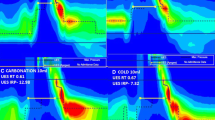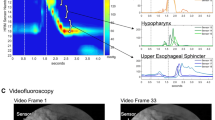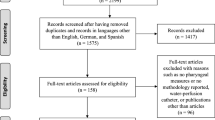Abstract
The purpose of this study is to determine the level of patient comfort during pharyngeal high-resolution manometry (HRM) with and without the use of atomized lidocaine. A secondary aim of the study was to explore whether differences in pharyngeal pressure measurements exist between HRM conducted with the use of atomized lidocaine verses HRM conducted without. Twenty-nine participants underwent two HRM procedures under two conditions, 5–7 days apart: 2% viscous lidocaine to nares or 0.4 mL 4% atomized and 2% viscous lidocaine to nares. During each procedure, participants received six boluses of water. Following catheter removal, participants were asked to rate comfort using a visual analog scale (VAS) and upon completion of both conditions, participants indicated which procedure they preferred. A paired t-test was used to compare pharyngeal pressure measurements at the velopharynx, tongue base region and during upper esophageal sphincter opening. Pharyngeal pressures were categorized as normal or outside of normal limits and compared using a McNemar’s test. Twenty-eight of the 29 participants indicated they preferred the use of atomized lidocaine. VAS ratings yielded a significant difference (p = 0.001). No significant difference in pharyngeal pressures were detected between the two groups. Patients prefer atomized lidocaine when undergoing HRM. The use of atomized lidocaine did not affect measurement outcomes.
Similar content being viewed by others
References
Knigge, M., Marvin, S., Thibeault, S. (2018). Safety and tolerability of pharyngeal high-resolution manometry. American Journal of Speech-Language Pathology, 1–10.
Sunkaraneni V, Jones SE. Topical anaesthetic or vasoconstrictor preparations for flexible fibre-optic nasal pharyngoscopy and laryngoscopy. Cochrane Database Syst Rev. 2011;3:005606.
Lester S, Langmore SE, Lintzenich CR, Wright SC, Grace-Martin K, Fife T, Butler SG. The effects of topical anesthetic on swallowing during nasoendoscopy: anesthetic effects on swallowing. The Laryngoscope. 2013;123(7):1704–8.
O’Dea MB, Langmore SE, Krisciunas GP, Linsey MW, Zanchetti L, Scheel R, McNally E, Kaneoka AS, Guarino AJ, Butler SG. Effect of lidocaine on swallowing during FEES in patients with dysphagia. Annals of Otology, Rhinology & Laryngology. 2015;124(7):537–44.
Fife TA, Butler SG, Langmore SE, Lester SS, Wright C, Kemp S, Grace-Martin K, Lintzenich CR. Use of topical nasal anesthesia during flexible endoscopic evaluation of swallowing in dysphagic patients. Annals of Otology, Rhinology & Laryngology. 2015;124(3):206–11.
Guiu Hernandez E, Gozdzikowska K, Apperley O, Huckabee ML. Effect of topical nasal anesthetic on swallowing in healthy adults: a double-blind, high-resolution manometry study: effect of topical anesthetic on swallowing. The Laryngoscope. 2018;128(6):1335–9.
Hoffman MR, Ciucci MR, Mielens JD, Jiang JJ, McCulloch TM. Pharyngeal swallow adaptations to bolus volume measured with high-resolution manometry. The Laryngoscope. 2010;120(12):2367–73.
Rosenbeck J, Robbins JA, Roecker EB, Coyle JL. A penetration aspiration scale. Dysphagia. 1996;11:93–8.
Acknowledgments
The authors would like to thank Eileen Peterson, Associate Research Specialist, for assistance with recruitment and data analysis, and Mero Kitila, MS, CCC/SLP for assistance with data analysis.
Funding
This work was funded by the Diane M. Bless Endowed Chair.
Author information
Authors and Affiliations
Corresponding author
Ethics declarations
Conflict of interest
The authors declare that they have no conflict of interest.
Additional information
Publisher's Note
Springer Nature remains neutral with regard to jurisdictional claims in published maps and institutional affiliations.
Rights and permissions
About this article
Cite this article
Hernandez, J., Leverson, G. & Thibeault, S. Effect of Lidocaine on Comfort and Swallowing Pressures During Pharyngeal High-Resolution Manometry. Dysphagia 36, 439–442 (2021). https://doi.org/10.1007/s00455-020-10157-4
Received:
Accepted:
Published:
Issue Date:
DOI: https://doi.org/10.1007/s00455-020-10157-4




